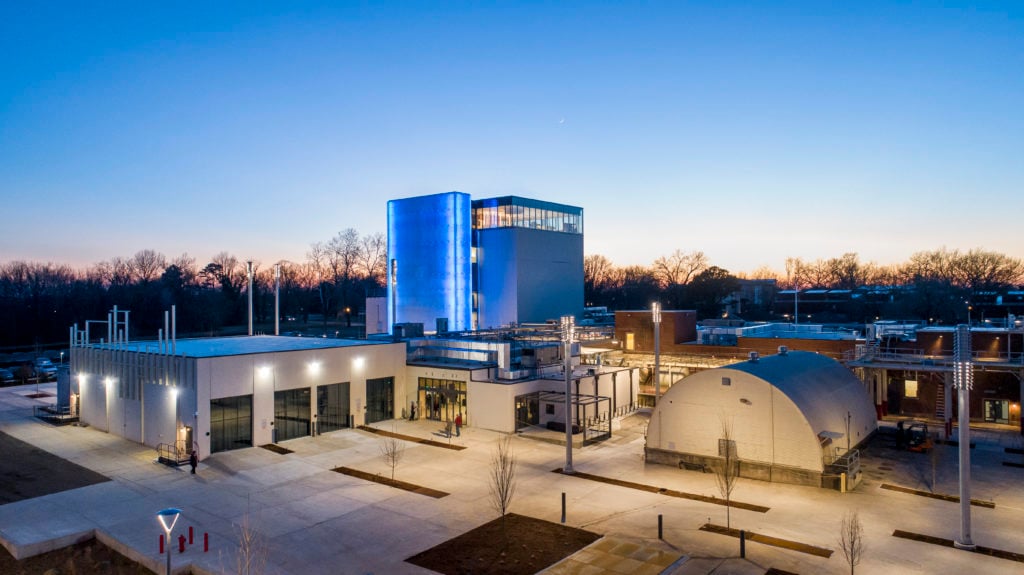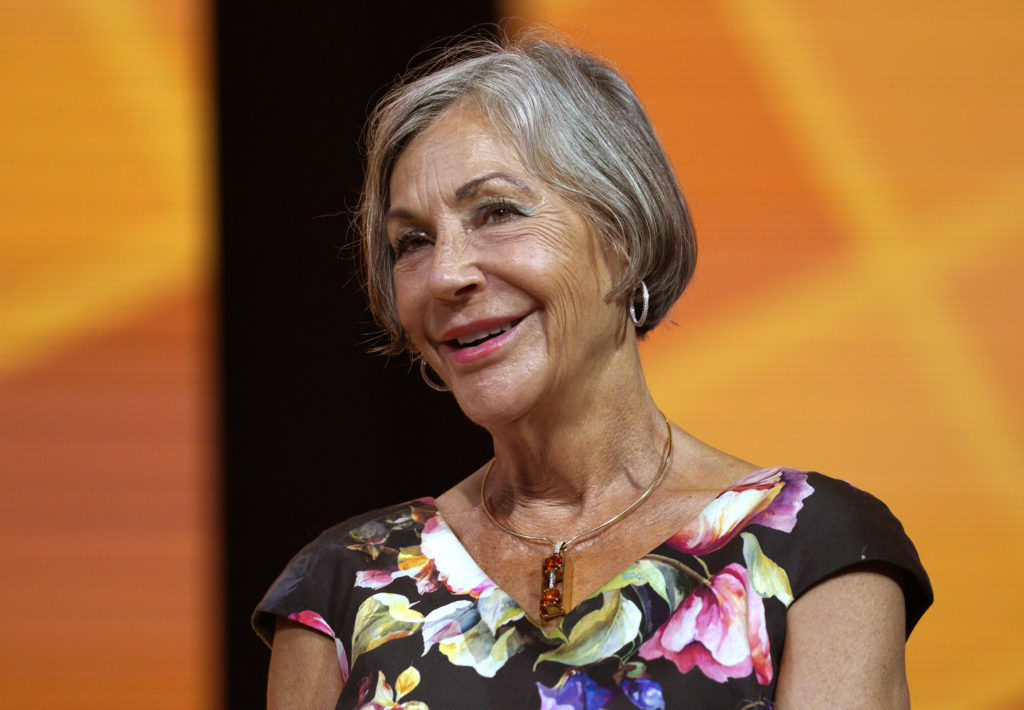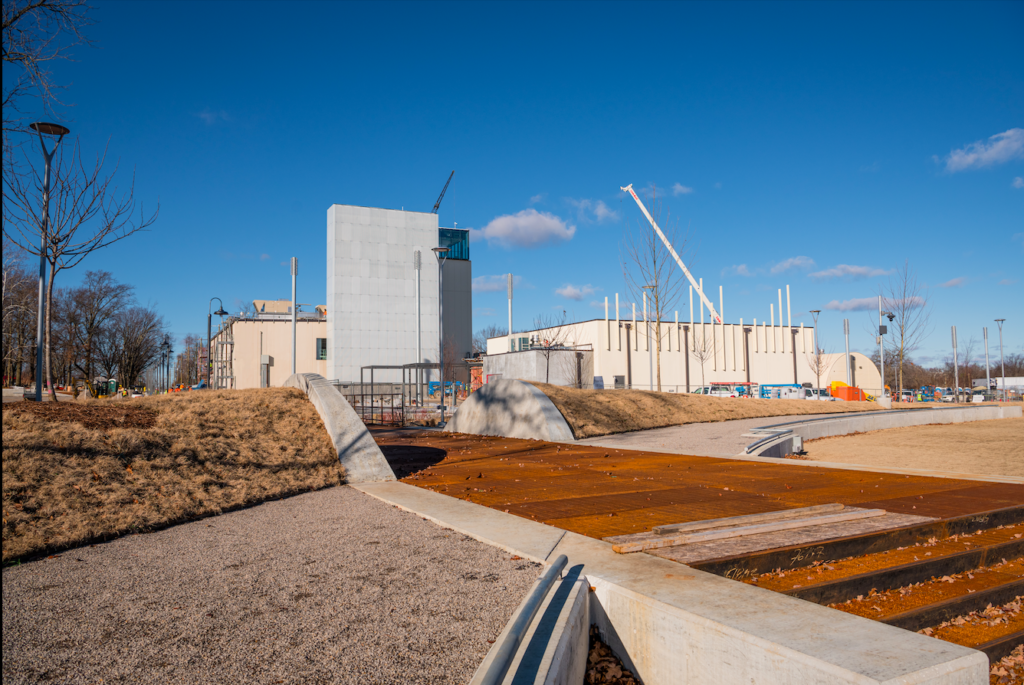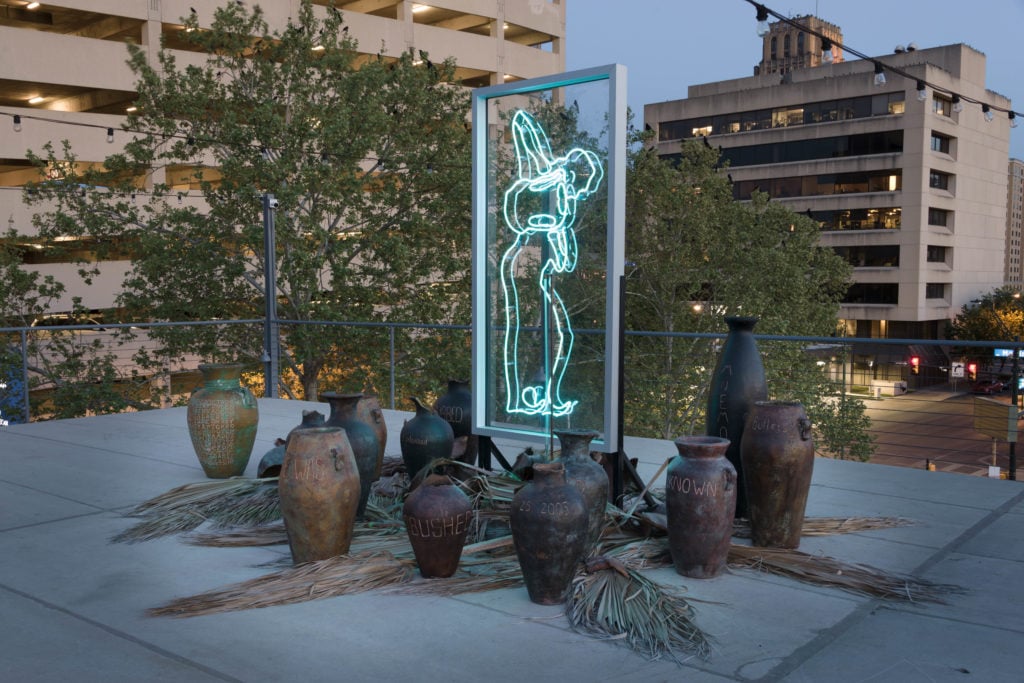Art World
Crystal Bridges Made Arkansas a Hub for American Art. Can a New Offshoot Make It a Destination for Contemporary Work, Too?
Nimble and ambitious, the Momentary aims to bring fresh creative energy to a repurposed Kraft plant.

Nimble and ambitious, the Momentary aims to bring fresh creative energy to a repurposed Kraft plant.

Here’s an accelerated timeline that sums up the unexpected rise of a massive art museum in the American South.
Throughout the early aughts, Dayton Castleman finds himself traveling back and forth from Chicago to Northwest Arkansas to visit his parents, who had moved to Siloam Springs. In 2008, Walmart heir Alice Walton bid to purchase an iconic painting called The Gross Clinic, by Thomas Eakins, for a museum she plans to open in nearby Bentonville, causing a national stir—not least of all because it would mean the piece would move from Philadelphia to its new home in rural Arkansas. (The sale ultimately did not go through).
Castleman, who had previously assumed Walton’s Crystal Bridges Art Museum would simply be a repository for scenes of the Wild West, starts to reconsider his prejudices. Fast forward ten or so years and the artist now feels such an enthusiasm for the venture that he’s relocated permanently to Arkansas, moving there shortly after Crystal Bridges formally opened its doors in 2011. He reasoned, at the time, that the institution could do for Bentonville what the Guggenheim did for Bilbao.

Alice Walton in Arkansas. Photo by Rick T. Wilking/Getty Images.
The effects Crystal Bridges has had on the region are more than clear. And later this month, the museum is going one step further. It’s opening a satellite contemporary art center, the Momentary, which, by all accounts, is expected to further solidify the impact art has had on this town that once counted the Walmart Museum as one of its biggest cultural attractions.
Alice Walton, daughter to the founder of Walmart (which is headquartered in Bentonville), introduced the idea of Crystal Bridges in 2005, right after the city released its 2004 Master Plan to revitalize the downtown. What was to follow has been described to me as the institution serving an anchor, pillar, or gravitational center around which everything else culture-related orbits. Calling the Crystal Bridges one of the main drivers of these revitalization plans would be an understatement given how much municipal and private investment (including from the Walton family), residential development, tourist revenue, and population growth (which impacts the family’s businesses) have been attributed to the museum.
“The Momentary obviously is an extension of Crystal Bridges,” says Castleman, “the scaling up of an existing institution that precipitated this change and has really provided the scaffolding for this sort of urban transformation.”
The Momentary is tied to Crystal Bridges in so many ways. The museum didn’t incorporate contemporary art in its initial blueprint, which “basically makes the case for the Momentary almost immediately, because you have a square footage problem almost from the get go,” says University of Arkansas art professor Sam King.
Crystal Bridges curator Manuela Well-Off-Man, who joined the museum back in 2009, explains that the collection was “supposed to end with American modernism.” The arrival of director Don Bacigalupi that same year, she says, shifted that equation.
By the time the plan for the Momentary was announced, in 2016, Well-Off-Man says the curators, “were all excited that this would be the answer to all the questions of, for example: How can we include more regional artists? Or how can we explore maybe some other art forms that wouldn’t be a good fit for the museum because it’s not part of the mission?”
The Momentary is certainly more flexible than its parent institution. Repurposed from an old Kraft cheese plant, the 63,000 square foot contemporary art space will include room for visual art, performing arts, and culinary experiences. “They may be looking to connect with the region,” suggests King, by “creating the space where somebody might go to something that has sort of pop appeal, and then they stay for something that is [more experimental.]”
The center expands on the cultural footprint established by the Crystal Bridges, and has opened within a decade of the museum’s arrival on the scene, establishing a pace that has been completely unmatched by other satellite offshoots of major institutions, like Tate Modern or Dia: Beacon.

A view of the Momentary construction site. Photo: Stephen Ironside, courtesy of the Momentary, Bentonville, Arkansas.
When Bentonville drafted its plan for the district where the Momentary is located, which conveniently connects downtown Bentonville with Walmart’s relocated future home office (with nearly “15,000 people in the home office area every day” says city official Brian Bahr, “to ultimately support [the district]”), planners had already made room for a robust arts component owing to the success of Crystal Bridges in incubating a culturally rich community that now includes restaurants, bars, and bike and hiking trails. The Walton family swooped in with its idea to create the Momentary two years later.
And that has happened a lot. The family has spearheaded the development of this “ecosystem”—which, along with these two institutions, includes the School of Art at the University of Arkansas, established in 2017 using a historically large foundation endowment, along with other art projects, grassroots and otherwise, in Northwest Arkansas.
The Waltons have also played a role in the affordable housing initiative for the (albeit nascent) artist community, which will be located next to the Momentary. “Having another space there for artists will be very synergistic,” according to Artspace senior Vice President Wendy Holmes, who conducted a Walton Family Foundation-supported market study on the needs of the community (the double-edged sword of arts-induced gentrification.) If there have been any flaws in how these initiatives have played out, you’d be hard-pressed to hear them from anyone in the local creative sphere. They feel too indebted to the Waltons for creating an art world big enough to actually support them.
Castleman adds that for people like him, creatives “who just want to be a part of this crazy formation of a new art world,” and the chance to be influential in a way they might never be in places like Chicago, Philadelphia, or New York, an institution like the Momentary is important. It “creates another sort of pillar of: This is how we conduct ourselves,” he says.
A biennial-style show often is a good way to raise the profile of an institution and the area surrounding it.
The second iteration of “State of the Art”—technically a quinquennial, running on a 5-year cycle—will inaugurate the new space. The show debuted at Crystal Bridges in 2014, and provided a lot of positive momentum and enthusiasm, according to Well-Off-Man, for its budding contemporary art program.
This year, “State of the Art” will take over both institutions. The weight of the inaugural show was, many noted, subsumed by its premise, with a number or articles (and even a documentary) focusing in on how founding director Don Bacigalupi and curator Chad Alligood traversed the country to select artists for it.

Installation view of Sama Alshaibi’s The Cessation in “State of the Art 2020.” Courtesy of Sama Alshaibi; originally commissioned by Artpace San Antonio. Photo: Seale Photography Studios. ©Artpace San Antonio.
Since at its core, the show will always be committed to “representing artists from the 48 contiguous states,” Glenn says, it’s possible that the institution’s idea of making sure to not leave anyone out—especially those who’ve been historically overlooked—has given way to a realization that filling gaps isn’t a one-time proposition each cycle. Instead of emphasizing the miles they’d traveled, this curatorial team—led by Studio Museum in Harlem alum Lauren Haynes, who works for both institutions, and Crystal Bridges’s contemporary art curators Allison Glenn and Alejo Benedetti—took it slowly. They allowed themes to “rise to the top,” Haynes says, and narrowed down their selections accordingly. Some work they saw wasn’t right for “State of the Art,” she says, but might resurface in a later show at the Momentary.
According to participating Fayetteville-based artist Anthony Sonnenberg, they’ve done “a great job of finding those artists that have been kind of local legends in their communities, but for whatever reason have not gotten full success.” That includes artists such as Dallas-based Frances Bagley and Georgia legend Larry Walker (who happens to be Kara Walker’s father), situated alongside lesser-known artists who are beyond “emerging,” like Ronald Jackson, whom Glenn visited in Spotsylvania, Virginia.
Crystal Bridges is unburdened by any real legacy issues. That makes it easier for the museum and its new contemporary art offshoot to chart a course “that does not have any prior precedent,” says King. Apart from not having to reckon with much baggage, he continues, they can represent the contemporary moment somewhat unabated.
“They have no reason to do anything other than what works today,” he says.
The Momentary in Bentonville, Arkansas opens to the public on Saturday, February 22.